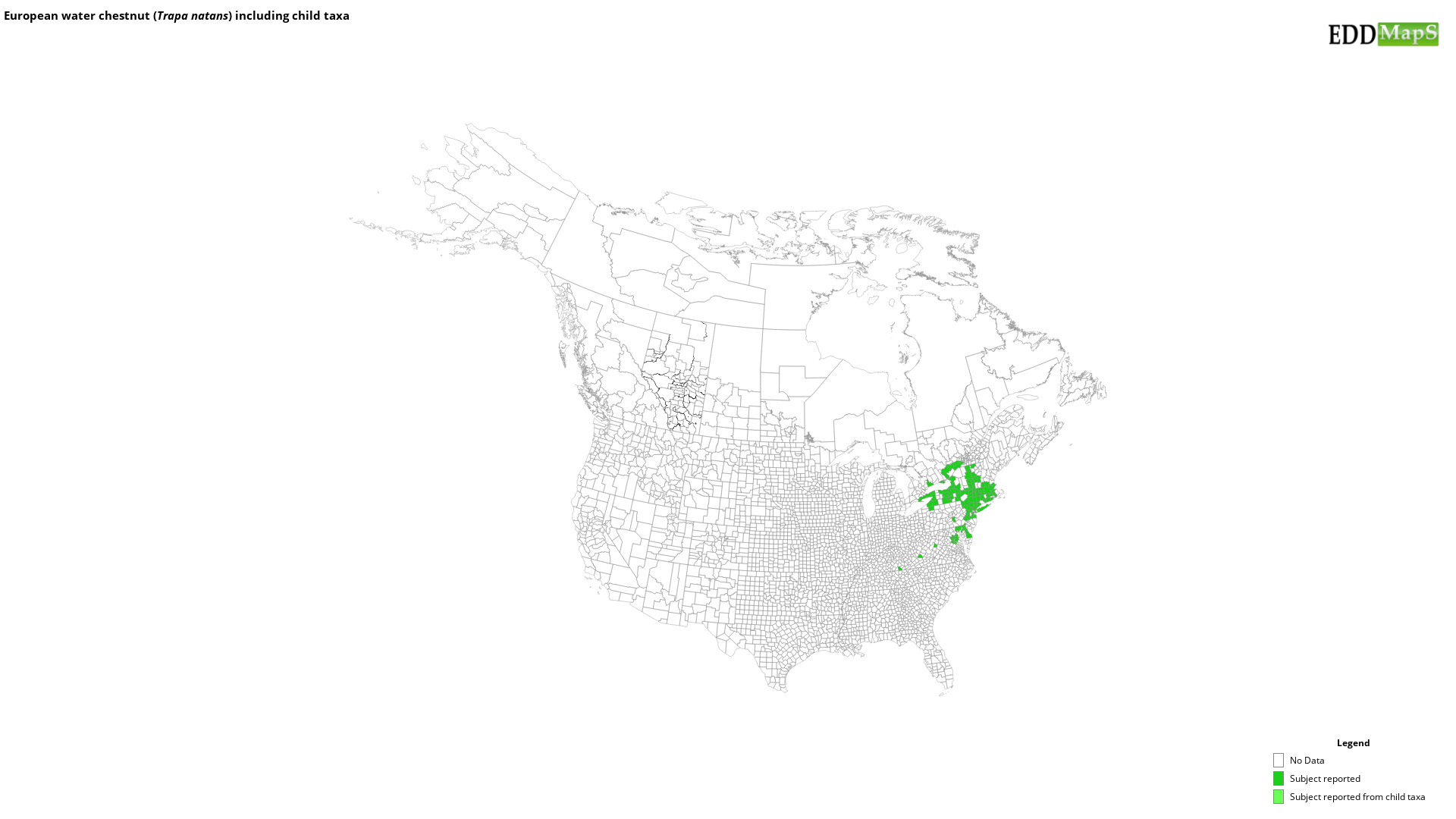European water chestnut
(Trapa natans)
This species is Introduced in the United States
Trapa natans is a rooted, floating plant that invades shallow to deep, freshwater habitats in the northeastern United States. It can grow in 12-15 ft. (3.6-4.6 m) of water and forms dense, floating mats, often three layers deep.
Foliage
The rosette of leaves on the surface of the water are alternate, triangular in shape, strongly dentate (toothed), and connected to the stem by an inflated petiole. Submerged leaves are feathery and either opposite or alternate.
Flowers
Trapa natans has small, four-petaled flowers that bloom from July to frost.
Fruit
The nut-like fruit has two to four, 0.5 in. (1.3 cm) long, sharp, barbed spines. They ripen in about a month and can remain viable as long as 12 years. Each seed can produce 1-15 rosettes and each rosette can produce as many as 20 seeds. The spines can penetrate shoes.
Ecological Threat
The dense, floating mats of Trapa natans restrict light availability, reduce the oxygen content, and displace other emergent and floating vegetation. It also limits boating, fishing, swimming, and other recreational activities. Trapa natans is native to Europe and Asia and was first observed in the United States in Massachusetts in the late 1800s.
Citations
Rawlins, K.A., R.L. Winston, C.T. Bargeron, D.J. Moorhead, and R. Carroll. 2018. New Invaders of the Southeast. USDA Forest Service, Forest Health Assessment and Applied Sciences Team, Morgantown, West Virginia. FHTET-2017-05. Retrieved from http://bugwoodcloud.org/resource/pdf/FHTET-2017-05_New%20Invaders_SE.pdf
Resources
- Biological Control of Invasive Plants in the Eastern United States - USDA Forest Service
- Global Invasive Species Database - Invasive Species Specialist Group
- Plant Invaders of Mid-Atlantic Natural Areas - National Park Service and U.S. Fish and Wildlife Service
- Fact Sheet - Ontarios Invading Species Awareness Program
Selected Images
Maps
EDDMapS Distribution - This map is incomplete and is based only on current site and county level reports made by experts, herbaria, and literature. For more information, visit www.eddmaps.org
State Lists - This map identifies those states that have this species on their invasive species list or law.
Invasive Listing Sources
- Alabama Noxious Weeds - Class C Noxious Weed
- Alberta Fisheries Act
- Commonwealth of Pennsylvania, Department of Conservation and Natural Resources, 1994.
- Connecticut Invasive Plant List
- Connecticut Invasive Plant Working Group
- Connecticut Noxious Weeds
- Idaho Noxious Weeds
- Indiana Invasive Species Council - Invasive Plant List
- Indiana Prohibited Plant Species
- Invasive Plant Species of West Virginia
- Jil M. Swearingen, Survey of invasive plants occurring on National Park Service lands, 2000-2007
- John Randall, The Nature Conservancy, Survey of TNC Preserves, 1995.
- Maryland Aquatic Nuisance Species Plan
- Maryland Code and Regulations Nonative Aquatic Organisms
- Maryland Department of Natural Resources Policy: Restriction on Planting Exotic Invasive Plants
- Maryland Invasive Species Council - Invasive Species of Concern in Maryland
- Massachusetts Invasive Plants Advisory Group List
- Massachusetts Noxious Weeds
- Massachusetts Prohibited Plant List
- Michigan’s Invasive Species Watch List
- Michigan’s Prohibited and Restricted Species
- Mid-Atlantic Field Guide to Aquatic Invasive Species
- Minnesota DNR invasive species list
- National Park Service, Mid-Atlantic Exotic Plant Management Team Invasive Plant List
- New Hampshire Prohibited Aquatic Species
- New Invaders of the Southeast
- New Jersey Invasive Species Strike Team 2017 Invasive Species List
- New York Regulated and Prohibited Invasive Species - Prohibited
- Nonnative Invasive Species in Southern Forest and Grassland Ecosystems
- Ontario’s Invading Species Awareness Program Tracked Species List
- Oregon Noxious Weeds
- Pacific Northwest Exotic Pest Plant Council, 1998
- Pennsylvania Department of Conservation and Natural Resources Invasive Plants
- Pennsylvania Noxious Weeds
- Pennsylvania's Field Guide to Aquatic Invasive Species
- Plant Invaders of Mid-Atlantic Natural Areas
- Rhode Island Natural History Survey
- South Carolina Illegal Aquatic Plants
- South Carolina Plant Pest List
- Tennessee Exotic Pest Plant Council
- Vermont Noxious Weeds
- Virginia Invasive Plant Species List
- Virginia Invasive Species Management Plan 2012
- WeedUS - Database of Plants Invading Natural Areas in the United States
- West Virginia Native Plant Society, Flora West Virginia Project, and West Virginia Curatorial Database System, September 3, 1999
- Wisconsin Noxious Weeds
- Wisconsin's Invasive species rule – NR 40
Taxonomic Rank
| Domain: Eukarya |
| Kingdom: Plantae |
| Phylum: Magnoliophyta |
| Class: Magnoliopsida |
| Superorder: Rosanae |
| Order: Myrtales |
| Family: Lythraceae |
| Genus: Trapa |
| Trapa natans |
References
Common Name Reference: Weed Science Society of America Common Names List
Scientific Name Reference: USDA, NRCS. 2010. The PLANTS Database. National Plant Data Center, Baton Rouge, LA, USA.


